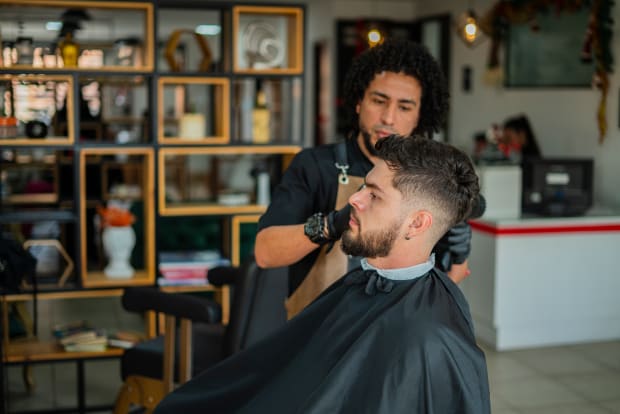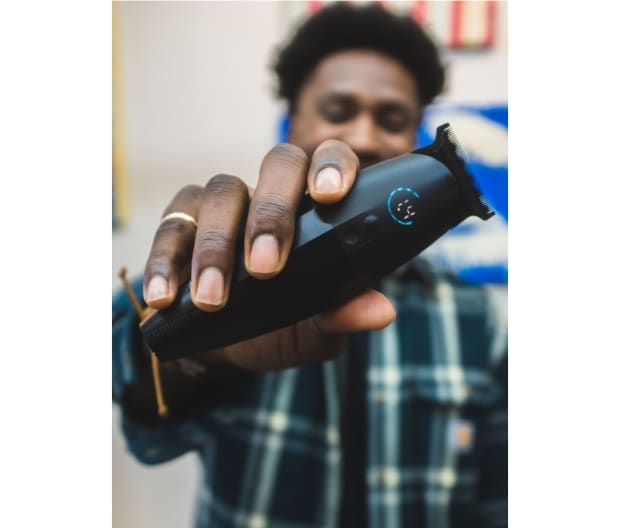Your look can greatly benefit from fading your beard. Here's how to do it right at home.
Like a fresh taper on any haircut, the beard fade is a flourish that really elevates your grooming game. It takes a small strip of real estate around the perimeter of your beard (usually the neckline, but sometimes the cheek lines and sideburns, too), and announces to the world you take pride in your appearance. And while most guys rely on their barber for this kind of handiwork, it’s quite the flex if you know how to fade a beard by yourself.
That said, beard fading does require some steady hands, serious focus, and the right products. It’s not exactly an entry-level task, either, so patience is key.
“On a scale of one to 10, I would put fading your own beard at a seven or eight,” says Dale Grinstead-Mayle, owner and barber at Goodfellow's Tonsorial Parlor, with barbershops in White Salmon, WA and Columbus, OH.
Related: 5 Best Beard Styles for Your Face Shape

Mario Arango/Getty Images
Beard Fade Dos and Dont's
Beard fading suits most types of beards, long and short, but might not be as effective in patchy beards or on guys with long, narrow faces.
“Fading or tapering will elongate your features even more,” notes Grinstead-Mayle. “This elongation or narrowing tends to pull a person's facial features downward, so if you have a naturally oblong face, it can make you look gaunt or perpetually exhausted, and can even age you.”
There are a variety of styles, too. You can do a low fade, which is shorter and low-maintenance, or a high fade with your beard that's longer and more voluminous.
Hey, nobody is going to question the freshness of an un-faded beard neckline anyway, so don’t stress if you’ve got a naturally longer mug. As for those with oval, round, diamond, and square faces, read on. Grinstead-Mayle takes us through the 101s of beard fading.
Related: 10 Ways to Look Better Instantly
Best Beard Trimmer, Clipper, and Comb to Fade Your Beard
Many guys at home will be using a standard beard trimmer. While that may suffice, it’s even better if you have some professional-grade hair clippers—ideally with an adjustable lever, Grinstead-Maybe notes. Either way, you’ll want guard attachments, ranging from #.5 (1/16" or 1.5mm) to #4 (1/2" or 12.5mm).
Andis master cordless for a barbershop-favorite device, Bevel Pro for a great hair-and-beard device (though it lacks the lever that Grinstead-Mayle prefers), or Hatteker for a low-cost, high-value device. The Panasonic MultiShape is up for the task, too, in terms of non-professional devices targeting both beard and hair. Just make sure the device you choose can trim between the lengths noted above.
You’ll also want a beard comb at the ready. Grinstead-Mayle likes ones made of sandalwood, but you can also use a regular fine-tooth comb. Rocky Mountain’s beard comb checks both boxes.
Invest in a good beard oil “to get the wild hairs to pop out during grooming” and some high-quality trimming shears for any blending as well as finishing touches (we like Suvorna).

Courtesy Image
How to Hold a Beard Trimmer
How you hold the trimmer really comes down to the direction of your hair’s growth. “Remember, going against the grain of the hair is to remove bulk. Going with the grain is to blend,” Grinstead-Mayle reminds. “Going sideways does a little of both.” Above all, go slowly, and you’ll bring the degree of difficulty down a few notches.
How to Fade a Beard
Remember, you’re not working with a large area here; fading a beard line isn’t like fading the backside of a fresh buzzcut. Instead, you’ll only be going in an inch at most.
- Start with the longer clipper guards and work your way back toward the shortest guard and the actual perimeter of the beard neckline. So, if your entire beard is, say, half an inch (which in terms of clipping guards, is a #4 length), you can trim on a #3 an inch past the beard neckline.
- Then, trim on a #2 and cover half of the same area that you went in on with the #3.
- Do it again with the #1 (halving the area of the #2).
- Lastly with a 0.5, clean up the perimeter. Envision it graduating downwards, but not over a long distance since you want to maintain the semblance of a full beard. If your beard is extremely long, you can get your barber’s own take on whether or not a fade will do you any favors (depending on if the beard covers it up). In the very least, you could fade it from the cheeks and sideburns up.
How to Shape a Beard Neckline
Hopefully you’re already well-tuned to drawing a neckline each time you clean up your beard at home. This is the same point from which you’ll start a beard fade. If you want a reminder, though, follow Grinstead-Mayle’s neckline tip:
- Set a line just under the corner of your jaw bone, under your ear.
- Then, set the line just above your Adam's apple, by putting your middle and index finger together and placing them horizontally with your middle finger on the Adam's apple. The top of the index finger is where to place the line.
- Next, connect the line from your jaw bone to the line above your Adam's apple.
How to Fade Your Cheek Beard
Fading the cheeks is effectively the same as the neckline, says Grinstead-Mayle.
- “Create your guide from the corner of where your beard curves in from your sideburn and connect it to the corner of your mouth or just above.” Even if you have a thin or patchy beard in this part of the face, you should follow your natural growth line, he adds.
- Pay attention to how you hold the clippers here: “Going with the grain of the hair (usually clippers pointed downward with a guard), is best for cleaning up the cheeks,” he says.
Beard Fade Maintenance
Just like with head fades, you should plan for routine cleanups every two to three weeks to keep beard fade fresh. This may vary based on how long your beard is or how quickly it grows (shorter beards will naturally benefit from more frequent cleanups).
And while you’ve now got the know-how to do a beard fade yourself, we’d be remiss not to advise checking in with a barber for a more tailored tutorial—one that fits your precise face, beard, and growth goals. You might even find that it makes sense to get these tidyings with each haircut. Or at the very least, they can set you on the path for success. “Once they set it, you can maintain the fade while at home, in between those visits,” says Grinstead-Mayle.
from Men's Journal https://ift.tt/wk6pRD8


0 comments